|
1.
CENTRAL/ WEST AFRICA
Prices for West African timber products largely stable
Prices for West African timber products remained unchanged in early May. Demand from India and Europe
remained firm while Chinese ports were still dealing with inventory build-up. Freight for China increased up to $35
per m3 due to delays in unloading. Meanwhile, rains in Gabon were hampering log production. Overall, market
activity was steady and likely to remain stable.
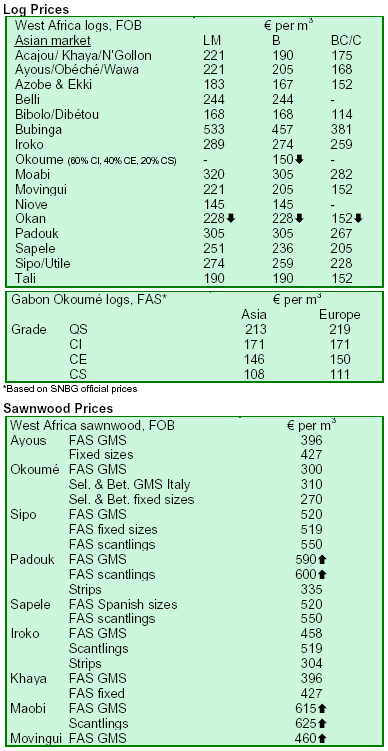
2. GHANA
New FC CEO to clear ¡°mess¡± in the forestry sector
The newly-appointed Chief Executive Officer of the Forestry Commission (FC), Prof. Nii Ashie Kotey has
indicated that there was a mess in the forestry sector and his immediate task was to clear it to ensure a sustainable
FC. He referred, in particular, to revenue leakages, low stumpage pricing, illegal chainsaw operations and lack of
maintenance of afforestation projects. He said that another
key issue was to ensure sufficient quantity of wood products on the local market, adding that in doing so, it
would help to curtail the rampant stealing of timber from the forest reserves. Prof Nii Kotey said his vision for the forestry sector was to make it self-sustainable by
improving collection of revenue and increasing stumpage fees, which he described as inadequate. He assured milling
companies that concessions would be allocated to them, so that they could continue to be in
business to curb mass unemployment. Prof Kotey said that carpenters at the Anloga market in Kumasi would relocate to the wood
village in the first quarter of 2008.
Ghana timber exports rebound in the first quarter
According to the Timber Industry Development Division (TIDD) of the Forestry Commission, export of wood
products rose to euro48.1 million (136,900 m3) in the first quarter of 2007 (see table). This
corresponds to 16.7% and 28.1% growths in value and volume, respectively, compared with 2006. The main reasons for the export
growth was improved prices and enhanced utilization of the installed capacity of timber companies operating
integrated processing mills.
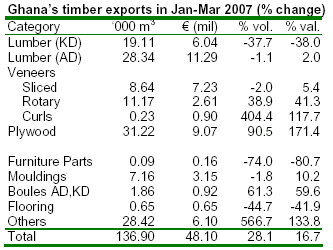
According to TIDD, sustained marketing and promotional
strategies of the Forestry Commission towards market and products diversification, especially for lesser used timber
species, also accounted for the increase. Primary wood products such as lumber, veneer, boules, billets and
plywood contributed about euro44 million (128,796 m3), equivalent to 91.5% and 94.1% of the total export value
and volume. Secondary processed wood products accounted for the balance.
India imported 38,312 m3 (euro8.8 million) of the timber products, making it the single largest importer. India was
followed by the USA (16,141 m3 worth euro6.6 million) and Nigeria (17,082 m3 worth
euro5.8 million). The USA was the largest importer of kiln-dried lumber and veneer while
Nigeria was the largest importer of plywood. Europe¡¯s share of the timber and wood products in the first quarter
reached 43,700 m3 (euro19.3 million), equivalent to 32% and 40.2% of the total export volume and value, respectively.
The largest Ghanaian exporters were John Bitar Company Ltd, Naja David Veneer, Logs and Lumber Company Ltd,
Samartex Timber and Plywood Ltd, and Fortuna Timbers Ghana Ltd, who accounted for about 43% and 44% of the
total export volume and value, respectively.
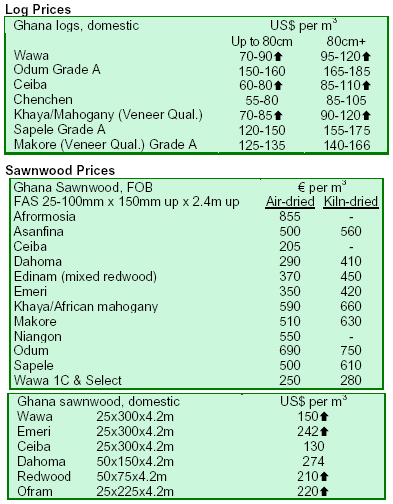
3.
MALAYSIA
Prices for timber products surge but likely to stabilize
Prices for Malaysian timber products rose moderately in early May, particularly those for
sawnwood, panel products and rubberwood furniture and parts. Prices are said to be steady and stabilizing as the dry monsoon sets in.
MTC promotes Malaysian timber products in Bahrain
The Malaysia Timber Council (MTC), Dubai office, will participate in the Gulf International Exhibition for
Construction, Interiors & Furniture (GulfBID 2007) in Bahrain to step up market development
efforts in the usage of Malaysian timber products and wooden furniture in countries within the Gulf Cooperation Council
(GCC). The three-day exhibition, which made its debut in 2006, will feature 200 exhibitors from 18 countries, with six
national pavilions. Malaysia's exports of major timber products to Bahrain stood at $12.12 million in Jan-Nov
2006. The main items exported during that period were
sawnwood ($2.4 million), plywood ($2.9 million), MDF ($2.3 million) and wooden and rattan furniture ($4.1 million).
A national economic survey indicated that total active projects in Bahrain were estimated at $27.43 billion. The
value of construction projects planned or under development in the Gulf exceeded $1
trillion by early April 2006. High oil prices have increased public and private sector confidence,
resulting in higher spending on property development and construction activities. The total
value of projects has reached an all time high due to a Gulf Cooperation Council-wide construction boom undertaken
by both public and private sectors.
Tax deduction on MTCC CoC expenses approved
The Malaysian Ministry of Finance, in line with section 154(l)(b) of the Income Tax Act 1967,
announced in March 2007 that all expenses incurred by companies in obtaining the MTCC chain-of-custody (CoC) certificate
would be eligible for tax deduction, beginning assessment
year 2007. The decision followed a proposal submitted by the Malaysian Timber Council (MTC) during the Ministry
of International Trade and Industry (MITI) annual dialogue 2005. The Ministry of Finance is currently
preparing the procedures for the implementation of this decision.
Sarawak companies concerned about forged log labels
Sarawak traders have expressed concern about some reports that logs of certain timber companies in Sarawak
were being forged and pirated. According to these reports, timber consignments of
unknown origin were being shipped to the Middle East using forged logos and stamps
of Sarawak companies.
Trade and technical mission goes to Eastern Europe
The Malaysian Deputy Plantation Industries and Commodities Minister, Datuk Anifah Aman, is
leading a trade and technical mission to Romania, Poland and Russia on 5-20 May. The mission seeks further
clarification on various issues concerning market access for Malaysian timber
products in these three countries, particularly in relation to EU regulations and tariffs.
Mr. Anifah said that the mission¡¯s objectives included informing the three countries about
Malaysia¡¯s forestry and sustainable forest management and seeking support and recognition for the Malaysian Timber Certification
Council's timber certification scheme. He will also lead three dialogue sessions with the timber business sector in
these countries to discuss issues openly. Malaysia¡¯s exports of timber and timber products to Romania, Poland
and Russia stood at 2.6 billion ringgit in 2006.
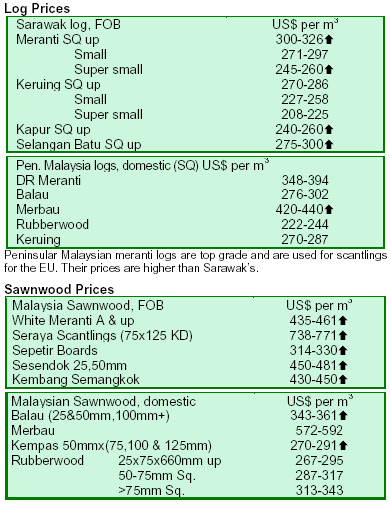
4.
INDONESIA
Prices for Indonesian products rise across the board
Prices for Indonesian timber products rose unabated across the board in early May. The continued crackdowns on
illegal logging kept having an impact on prices as demand remained firm in main international markets.
Indonesian building expected to reach pre-crisis levels
The Indonesian construction industry is slowly edging towards its pre-financial crisis growth level in the late
1990s. In the 2002-2006 period, the construction industry grew at an average of 7.1% a year, while the GDP grew
5.1%. Indonesian growth is expected to rise towards the 6% level in 2007, up from 5.5% in 2006. Indonesia's
benchmark interest rate may further decline toward 8.5%
by the end of 2007 from the current level of 9%. Oil prices remain high, but are lower than in 2006.
The Indonesian government has been striving to improve the statutory framework so as to make infrastructure
projects offered to investors more attractive and bankable. Under Presidential Decree No. 65 of 2006, the government
will encourage accelerated infrastructure development in Indonesia through investment cooperation, revolving
funds, subsidies (public service obligation), guarantees
and tax waivers.
Indonesia eyes increasing share in carbon trading
Director General for Forest Protection, Hilman Nugroho, said that Indonesian forests had a chance to share some 26
million tons out of the 36 million tons of total global market of carbon trading, provided under the clean
development mechanism (CDM). He said that with prices reaching between $3 and $5 per ton, Indonesia stood to
gain between $100 million and $180 million from carbon trading. He added that to improve its share in carbon
trading, Indonesia had to shift its focus on forest development from timber to non-timber because the
economic value of timber was only some 5% from the forest total economic value. Non-timber economic value
includes environment services such as water and hydrology services, climate protection through carbon absorption, and biodiversity protection.
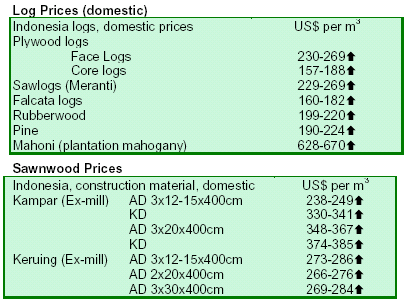
5.
MYANMAR
Unbalanced supply-demand keeps teak log prices firm
Prices for teak logs in Myanmar remained firm. Strong demand and unbalanced teak log
demand-supply in Yangon contributed to firmer prices. The May-October rainy season has started and transportation of logs from
up-country to Yangon was becoming more difficult. Some regular buyers mentioned difficulties in getting ¡®contract
material¡¯ to ship out. Another factor driving prices up was the increasing amount of logs from good areas in the
tender sales, with logs from less preferred areas going to the direct sale contracts. This is said to have attracted
greater participation by European buyers in tender sales.

Meanwhile, the pyinkado log market remained sluggish
while that for gurjan logs was firm. However, as the rainy season progresses, fresh logs would be preferred to those from the previous year¡¯s extraction.

6. PAPUA
NEW GUINEA
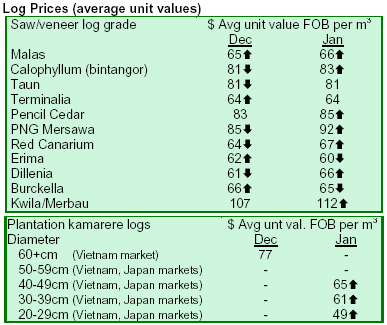
7. BRAZIL
US hardwoods an alternative to furniture exporters
The USA bought more than $366 million of Brazilian furniture in 2006, far below the $12 billion in
furniture imported from China that year. In 2006, Brazilian furniture exports to the USA fell 23%
while US total imports of these products grew 7%. According to the American Hardwood Export
Council (AHEC), Brazil needs to import more US hardwoods to increase its market
share in the USA. AHEC sees Brazil as a potential importer of $280 million a year of US hardwoods for
reexporting to international markets, mostly in the form of finished products. According to
AHEC, US hardwoods do not compete with Brazilian species and represent an alternative for the Brazilian furniture industry. Brazilian
exporters would be able to export furniture due to the good acceptance of US hardwoods, especially in the Northern
Hemisphere.
Caraj¨¢s mulls creation of sustainable forest district
The Caraj¨¢s Pig-Iron and Steel cluster region, located in the border of states of
Par¨¢, Tocantins and Maranhao, is the
world biggest producer of iron ore. It has 14 pig-iron producers, which consume annually around 13 million
m3 of fuelwood transformed into charcoal for the process. In addition, the region has 11 lumber clusters that consume
around 3.3 millions m3 of sawlogs a year. The illegal
deforestation in the region has created an environmental liability as the activity accounts for 40% of the region. From
2005 to 2006, 200,000 m3of charcoal was apprehended, resulting in 500 million reais of fines.
To address this problem, the federal government, led by its Civil House and in partnership with state governments of the
three states, has studied the creation of a sustainable forest district in the region. The focus of the plan is on forest
plantation to recover the forest cover, sustainably supply
pig-iron and steel companies and create jobs. The plan intends to create job opportunities in 1.5 million ha of forests,
9.6 million ha of deforested area (for plantation) and 4.8 million ha of legal
reserves to be recovered. The total area would sustainable produce 5 million m3 of sawlogs and 17
millions m3 of charcoal. A decree creating the Caraj¨¢s Sustainable Forest District is expected to be issued in the
second half of the year.
Brazil to sign Tropical Forest Conservation Treaty
The US Secretary of State has recently proposed Brazil to sign the Tropical Forests Conservation Treaty. The treaty
was created by the US government in 1998 in order to wave the debts of developing countries with the USA and
generate funds for environmental protection. The program
is implemented through bilateral agreements. Other Latin American countries that have already benefited from the
treaty are Peru, Colombia, Paraguay and Panama. According to the US State Department, the treaty could
generate $60 million in initiatives for environmental protection and investment in the preservation of forests
and wildlife.

8. PERU
Exporters association proposes a new logging model
The Peruvian Association of Exporters (ADEX) proposed a new economic model in which logging export companies
and forest communities would share responsibilities and profits as part of a
binding contract. The company would assume the responsibility of logging, processing and
commercializing the lumber, while both forest communities and forest owners would be responsible for
monitoring and supervising proper forest management with the technical assistance of a
professional team previously appointed. According to ADEX, this model would be one of the most viable economic choices to
improve life quality of native people and a tool to combat illegal logging. Promoting private investment in
unreachable poor zones, where communities lack the funds and infrastructure to use forest resources in a
sustainable way, would be conducive towards reaching
these objectives, ADEX said.
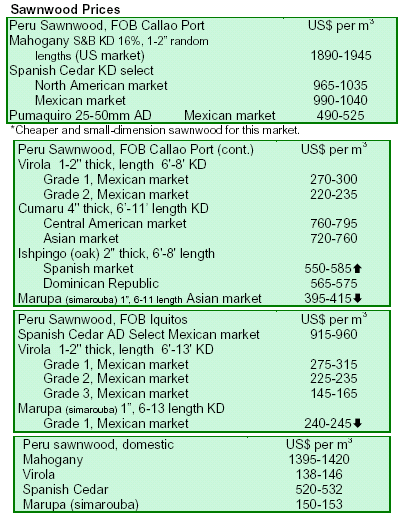
9. BOLIVIA
SF abolishes restriction on sawnwood exports
The Bolivian Forestry Commission (SF), through Resolution No 46/2007, has abolished the Resolution No
30/2007 of 3 April 2007 which restricted and forbade sawnwood exports. The Bolivian Forestry Chamber
(CFB) praised the resolution as the restriction was affecting the forest sector, particularly small and medium producers.
About 40% of the total Bolivian exports of wood products
are sawnwood while 60% are processed products such as floors, furniture and doors. The CFB
considered that the best way to promote the industrialization of the forest sector is through
incentives such as credit and tariff breaks, allowing small and medium producers to buy or modernize processing equipment.
Certified wood products gain share of total exports
Bolivia exported $21.4 million of FSC-certified wood products in 2006, 22.3% of total wood exports. Certified
wood products averaged a 19% annual compound growth rate from 2002 to 2006, compared with 15% for
non-certified wood products. In terms of area, certified forest grew at an average of 19% a year in 2002-2006. The
upward trend of exports of certified wood products is expected to continue. Preliminary data for the first quarter
of 2007 in Santa Cruz and La Paz (about 80% of nation total) showed a 102% increase in the export of certified
wood products to $11.6 million, compared with the same period in 2007.
Cooperative signs emissions reduction agreement
An emissions reductions purchase agreement was signed between the Community Development Carbon Fund,
managed by the World Bank and SAGUAPAC, a Bolivian sanitation and waste water treatment cooperative. The
agreement was signed during Carbon EXPO 2007, the largest trade fair and conference for the global carbon
market, in Cologne, Germany. According to the agreement, the Carbon Fund will buy 200,000 tons of
carbon dioxide equivalent by 2015. Part of the revenues
from this operation will be used for a community benefits plan to improve sanitary sewage services in one of the poorest areas of Santa Cruz de la Sierra, the largest city in
Bolivia.

10. Guatemala
Pine dominates Guatemalan wood products exports
The export of wood products reached $23.6 million in the first four months of 2007. Pine accounted for 43.8% of the
total. Among tropical hardwoods, mahogany accounted for 10.1%, Cedar (Cedrela odorata) 0.85%, Santa Maria(Challophyllium
brasiliensis) 0.64 % and teak 0.3% (mainly to the Indian market).

11.
Guyana
Government suspends operations of logging company
The operations of Chinese-owned Jailing Forest Industries Inc. (JFII) have been suspended by the government after
the company repeatedly failed to comply with agreed on performance standards and ignored several warnings to
implement corrective measures. The suspension by theMinister of Agriculture, Mr. Robert Persaud, followed a
recommendation made by the Guyana Forestry Commission (GFC). The ministry said JFII had been
awarded a Timber Sales Agreement (TSA) for 25 years, commencing 2005, after successfully filling all the
requirements of the State Forest Exploratory Permit.
Those requirements included the conduct of a Forestry Inventory (FI), preparation of a Forestry Management Plan
(FMP) and the carrying out of an Environmental and Social Impact Assessment (ESIA). However, the GFC
observed that progress in the implementation of critical aspects of JFII¡¯s business plan, such as the construction of
sawmill, kiln-drying complex and added-value facilities
were significantly behind schedule. To compound matters, the ministry added, the shareholders of the company were
recently engaged in major transfers of shares which have resulted in an internal shareholder dispute now being
addressed in China. The ministry said the change inshareholdings was done without the necessary disclosure
to the GFC. This triggered the immediate suspension of
the operations and various concessions of the company with effect from 16 April 2007 and until
further notice.


|